八年级英语Unit 6公开课教案
人教八年级下册英语Unit6优秀教学案例
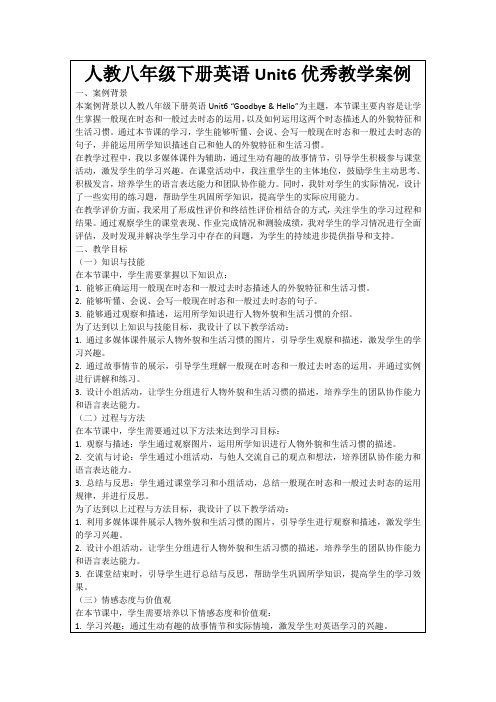
在学生小组讨论环节,我让学生分组进行讨论。我给每组学生提供了一些人物的照片,并要求他们用一般现在时态和一般过去时态描述这些人物的外貌特征和生活习惯。学生分组进行讨论,互相交流和分享自己的想法。通过这样的小组讨论活动,学生能够进一步巩固和运用所学知识,培养学生的团队合作能力和语言表达能力。
2. 能够听懂、会说、会写一般现在时态和一般过去时态的句子。
3. 能够通过观察和描述,运用所学知识进行人物外貌和生活习惯的介绍。
为了达到以上知识与技能目标,我设计了以下教学活动:
1. 通过多媒体课件展示人物外貌和生活习惯的图片,引导学生观察和描述,激发学生的学习兴趣。
2. 通过故事情节的展示,引导学生理解一般现在时态和一般过去时态的运用,并通过实例进行讲解和练习。
3. 在课堂结束时,引导学生进行总结与反思,帮助学生巩固所学知识,提高学生的学习效果。
(三)情感态度与价值观
在本节课中,学生需要培养以下情感态度和价值观:
1. 学习兴趣:通过生动有趣的故事情节和实际情境,激发学生对英语学习的兴趣。
2. 合作精神:通过小组活动,培养学生的团队合作意识和协作能力。
3. 自信与自主:鼓励学生积极参与课堂活动,大胆表达自己的观点,培养学生的自信心和自主学习能力。
5. 教学策略的综合运用:在本案例中,我综合运用了情景创设法、问题导向、小组合作、反思与评价等多种教学策略。这些教学策略的结合使得课堂更加生动有趣,能够满足不同学生的学习需求,提高学生的学习效果。通过这些亮点,本案例在教学设计、学生参与和知识运用等方面都表现出色,为学生的全面发展提供了良好的教学环境。
在情景创设中,我还运用了实物展示和角色扮演等教学手段。例如,我准备了一些人物模型的头部和身体部分,让学生通过组合这些模型,来描述人物的外貌特征。同时,我还让学生分角色扮演故事中的人物,通过表演的方式来展示人物的生活习惯。这样的教学方式不仅能够激发学生的学习兴趣,还能够帮助学生更好地理解和运用所学知识。
八年级英语下册第六单元公开课教案!Unit 6 How long have you been collecting shells?-sectionA1-教案2
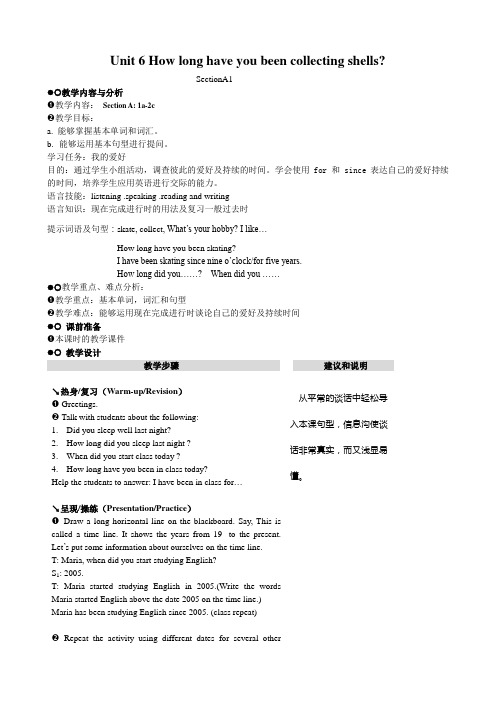
Unit 6 How long have you been collecting shells?SectionA1●教学内容与分析❶教学内容:Section A: 1a-2c❷教学目标:a. 能够掌握基本单词和词汇。
b.能够运用基本句型进行提问。
学习任务:我的爱好目的:通过学生小组活动,调查彼此的爱好及持续的时间。
学会使用for 和 since表达自己的爱好持续的时间,培养学生应用英语进行交际的能力。
语言技能:listening .speaking .reading and writing语言知识:现在完成进行时的用法及复习一般过去时提示词语及句型:skate, collect, What’s your hobby?I like…How long have you been skating?I have been skating since nine o’clock/for five years.How long did you……? When did you ……●教学重点、难点分析:❶教学重点:基本单词,词汇和句型❷教学难点:能够运用现在完成进行时谈论自己的爱好及持续时间●课前准备❶本课时的教学课件●教学设计教学步骤建议和说明↘热身/复习(Warm-up/Revision)❶ Greetings.❷ Talk with students about the following:1.Did you sleep well last night?2.How long did you sleep last night ?3.When did you start class today ?4.How long have you been in class today?Help the students to answer: I have been in class for…↘呈现/操练(Presentation/Practice)❶Draw a long horizontal line on the blackboard. Say, This is called a time line. It shows the years from 19- to the present. Let’s put some information about ourselves on the time line.T: Maria, when did you start studying English?S1: 2005.T: Maria started studying English in 2005.(Write the words Maria started English above the date 2005 on the time line.) Maria has been studying English since 2005. (class repeat)❷Repeat the activity using different dates for several other students. Use a different situation, such as When did you start to从平常的谈话中轻松导入本课句型,信息沟使谈话非常真实,而又浅显易懂。
新人教版初中英语八年级上册Unit 6 优质课公开课教案

新人教版初中英语八年级上册Unit 6 优质课公开课教案In Unit 6.students will learn how to talk about their ___ and express them using the phrases "be going to" and "want to be." They will also learn how to ___ of their plans such as what。
where。
when。
and how。
Some of the ns and fields that will be discussed include cook。
doctor。
engineer。
linist。
driver。
pilot。
pianist。
and scientist。
nally。
topics such as college。
n。
medicine。
and university will be covered。
___ countries.The key words that students will encounter in this unit include meaning。
discuss。
promise。
beginning。
improve。
physical。
hobby。
weekly。
schoolwork。
agree。
own。
personal。
and nship。
These words will help students to understand and discuss their ___.The knowledge goals of this unit include understanding key phrases such as grow up。
be sure about。
make sure。
write down。
have to do with。
人教版英语八年级上册Unit6课时教学设计

讲授新知后,我会组织学生进行小组讨论。将学生分成若干小组,每组选择一个话题,如“daily routine”, “weekend activities”等。小组成员用一般现在时和频率副词,讨论并描述他们自己或组内成员的日常习惯。讨论过程中,我会巡回指导,及时纠正学生的语言错误,并提供帮助。讨论结束后,每个小组选派一名代表汇报讨论成果,其他学生认真聆听并给予评价。
3.教学评价设计:
-采用形成性评价,关注学生的学习过程,通过课堂表现、小组讨论和课后作业,全面评估学生的学习效果。
-设定明确的评价标准,如语言准确性、流利度和创造性,鼓励学生自我评价和相互评价。
4.教学支持:
-提供丰富的教学资源,如多媒体课件、网络资源和实物教具,增强学生的学习体验。
-针对不同学生的学习需求,提供个性化的辅导和指导,帮助每个学生克服学习难点。
-阅读教学中,采用任务型阅读模式,引导学生关注文章结构和作者观点,通过问题链的形式,帮助学生深入理解文章内容。
2.教学方法运用:
-采用交际法教学,鼓励学生参与到课堂讨论和互动中,提高口语表达能力。
-运用任务驱动法,设计具有挑战性和趣味性的学习任务,激发学生的学习兴趣和探究欲望。
-引入合作学习,通过小组合作完成项目,培养学生的团队合作能力和自主学习能力。
(四)课堂练习
在学生掌握了新知识后,我会设计一些课堂练习来巩固所学。练习包括以下几部分:
1.填空题:让学生根据句意,选择合适的频率副词和动词形式填空。
2.句子转换:要求学生将一般现在时的句子转换为含有频率副词的句子。
3.对话练习:设计情景对话,让学生两人一组进行角色扮演,运用所学知识进行实际交流。
4.阅读理解:提供与日常生活习惯相关的文章,让学生阅读并回答问题,锻炼阅读理解能力。
八年级英语下册第六单元公开课教案!Unit 6 How long have you been collecting shells?-sectionA2-教案2
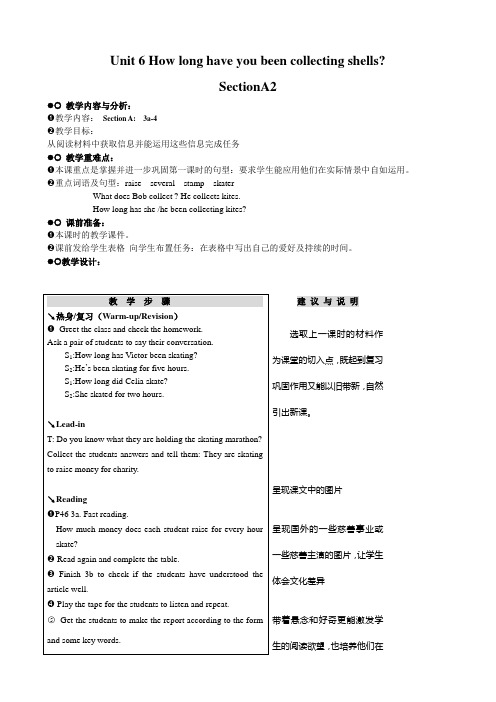
Unit 6 How long have you been collecting shells?SectionA2●教学内容与分析:❶教学内容:Section A: 3a-4❷教学目标:从阅读材料中获取信息并能运用这些信息完成任务●教学重难点:❶本课重点是掌握并进一步巩固第一课时的句型:要求学生能应用他们在实际情景中自如运用。
❷重点词语及句型:raise several stamp skaterWhat does Bob collect ? He collects kites.How long has she /he been collecting kites?●课前准备:❶本课时的教学课件。
❷课前发给学生表格向学生布置任务:在表格中写出自己的爱好及持续的时间。
●教学设计:建议与说明选取上一课时的材料作为课堂的切入点,既起到复习巩固作用又能以旧带新,自然引出新课。
呈现课文中的图片呈现国外的一些慈善事业或一些慈善主演的图片,让学生体会文化差异带着悬念和好奇更能激发学生的阅读欲望,也培养他们在文章中迅速获取所需信息的能力。
尽可能多的让学生模仿跟读,听地道的英语模仿表达是自由表达的基础,让学生根据已有信息再经过A: He has been waiting for the train for an hour.1.Q:How long have you been working in this restaurant?(two years)A: I’ve been working here for two years.3a的报道说出小组中进行询熟练句型、强教师抽查个别小组情学(按口语无语法错误或打在屏。
人教版八年级英语unit6教案

Unit 6 How long have you been collecting shells ?一.Teaching goals:1、Knowledge Objectives:a) Using the Present Perfect Progressive Tense.(How long have you been doing sth ?) ,and review the general past tense and Present progressive tenseb) Grammar focus: How long have you been doing sthI have been doing sth since ……I have been doing sth for … (period of time)2、Ability Objectives :a) To learn how to use the Present Perfect Progressive Tense.b) To t rain students’ability of self-study and communication.3、Moral Objective:Through talking about the hobby, express one's own view , make students respect and understand others in the communication, exchanges different views, find out others' taste , promote the friendly feelings .二.Teaching Focus:1、Using the Present Perfect Progressive Tense.(How long have you been doing sth ?) ,and it is important to distinguish General Past Tense and Present Perfect Progressive Tense.2、Grammar focus:How long have you been doing sthI have been doing sth since … .I have been doing sth for … (period of time)三.Teaching difficulties:1、The concept and meaning of The Present perfect progressive tense.2、It is important distinguish between General Past Tense and Present Perfect Progressive Tense. And use the Present Perfect Progressive Tense collectly.四.Teaching Methods: speaking ,exercise,listening, reading五.Teaching Time : the Second Period六.Teaching ProceduresStep1leading in the new class by introducing myself .1、I am a young teacher .I started to teach English in 2004.In this unit we are going to talk about how long we have been doing things,You can ask the teacher: How long have you been teaching English ?I have been teaching English for 7 years or I have beenteaching English since 2004.2、Ask students when did you study English? In which year?Are you studying English now ?How long have you been studying English ?I have been studying English for ( ) years.I have been studying English since ( ).Step2 Read and translate.Step3 Fill in the blanks.Step4Conclusion.Step5 Make conversations in pairs.Step6 Guessing game: who is he ?step 7 To learn how to use the Present Perfect Progressive Tense by reading.Step8 Fill in the blanks using “for” and “since” and explain the“since ”“and for”.Step 9 Distinguish General Past Tense and Present Perfect Progressive Tense.Step 10 Play the recording and get Ss to fill in the chart . Correct the answers .Step 11 In pairs ,get the students to ask and answer .Then ask some to do a survey and make a report.Step 12. Do a writing about Chenlong.Step 13. Summary.七、Homework1、Review the vocabulary2、Review the Present Perfect Progressive Tense.。
人教版英语八年级上册Unit6课时优秀教学案例
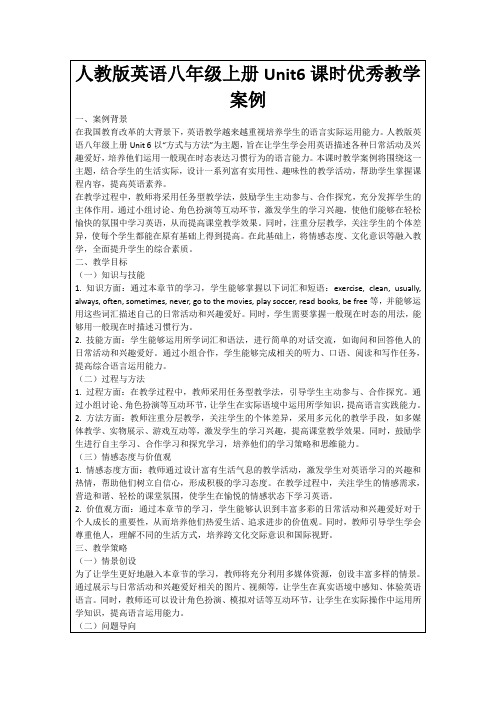
1.教师引导学生回顾本节课所学的主要词汇、短语和语法,总结一般现在时态的用法。
2.学生分享学习心得,交流在学习过程中遇到的困难和解决问题的方法。
3.教师对本节课的教学内容进行梳理,强调重点和难点,帮助学生巩固知识。
(五)作业小结
1.教师布置作业:要求学生用一般现在时描述自己的家庭成员的日常活动和兴趣爱好,并写成短文。
2.技能方面:学生能够运用所学词汇和语法,进行简单的对话交流,如询问和回答他人的日常活动和兴趣爱好。通过小组合作,学生能够完成相关的听力、口语、阅读和写作任务,提高综合语言运用能力。
(二)过程与方法
1.过程方面:在教学过程中,教师采用任务型教学法,引导学生主动参与、合作探究。通过小组讨论、角色扮演等互动环节,让学生在实际语境中运用所学知识,提高语言实践能力。
(四)反思与评价
1.反思:在教学过程中,教师引导学生进行自我反思,总结自己在学习过程中的优点和不足,找出需要改进的地方。通过反思,学生能够更加明确自己的学习目标,调整学习策略,提高学习效率。
2.评价:教师采用多元化的评价方式,包括自评、互评、小组评价和教师评价等。在评价过程中,关注学生的个体差异,充分挖掘每个学生的潜能,给予他们积极的评价和鼓励。同时,注重过程性评价,关注学生在学习过程中的表现,提高他们的综合素质。
1.教师呈现本节课的主要词汇和短语,如exercise, clean, usually, always, often, sometimes, never等,引导学生跟读并模仿。
2.教师讲解一般现在时态的用法,通过示例句和练习,让学生掌握用一般现在时描述习惯行为的用法。
3.教师组织学生进行听力练习,提高他们获取信息的能力,同时巩固所学词汇和语法。
八年级英语上册unit6教案(新版人教版)

八年级英语上册unit6教案(新版人教版)
教学目标
1. 研究和掌握有关电视节目的词汇和表达方式。
2. 了解并研究新闻报道的写作结构和技巧。
教学准备
1. 电视、投影仪和音响设备。
2. 学生课本和笔记本。
教学步骤
导入 (5分钟)
1. 播放一个关于电视节目的视频片段引起学生的兴趣。
新课讲解 (15分钟)
1. 介绍课程的主题和目标,激发学生研究的兴趣和动机。
2. 带领学生研究有关电视节目的词汇和表达方式,如电视剧、综艺节目、新闻报道等。
听力练 (10分钟)
1. 播放一段有关电视节目的对话,要求学生听并回答问题。
阅读活动 (20分钟)
1. 学生阅读一篇有关电视节目的新闻报道。
2. 学生回答问题,帮助他们理解报道的主题和要点。
语言实践 (15分钟)
1. 学生根据所学的词汇和句式,编写自己喜欢的电视节目的介绍。
小结与复 (10分钟)
1. 讲解和巩固本节课的重点内容。
2. 布置相关练作业。
教学提示
1. 鼓励学生积极参与课堂讨论和活动,提高他们的口语表达能力。
2. 及时纠正学生的语言错误,帮助他们提高英语听说能力。
作业
- 写一篇关于自己喜欢的电视节目的短文,包括节目名称、内容简介和个人观点。
字数不少于100字。
人教版八年级英语上册Unit6SectionB(2a2c)优秀教学案例

2.学生能够运用合作学习的方法,进行角色扮演、小组讨论等实践活动,提高英语实际运用能力。
3.学生能够在教师的指导下,通过听、说、读、写等环节,全面提高英语四项基本技能。
4.学生能够运用所学知识,解决实际问题,提高自己的创新能力和实践能力。
(三)情感态度与价值观
1.学生能够在学习过程中,培养对英语的热爱和兴趣,树立自信心,形成积极向上的学习态度。
四、教学内容与过程
(一)导入新课
本节课的导入环节,我选择了展示一组过去照片的方式。我提前准备了一组照片,包括学生们小时候的照片和一些过去的事件照片。在课堂上,我逐一展示这些照片,并询问学生们对这些照片的回忆和感受。通过这个活动,学生们能够自然地回忆起过去的事情,为接下来学习一般过去时打下基础。
(二)讲授新知
3.小组合作:在学生小组讨论环节,我组织学生们进行小组合作,让他们分工合作,共同完成任务。这种小组合作的方式不仅提高了学生的合作能力,还能够促进学生之间的交流和沟通。通过小组合作,学生们能够更好地理解和应用所学知识,培养他们的团队合作精神。
4.反思与评价:在教学过程中,我引导学生进行反思和评价,让学生们了解自己的学习成果和不足。这种反思与评价的方式不仅能够帮助学生巩固记忆,还能够激发学生们的学习积极性和主动性。通过反思与评价,学生们能够更好地了解自己的学习情况,提高自我监控和自我评价能力。
初中英语沪教版八年级上册Unit6《ReadingThe Trojan horse》优质课公开课教案教师资格证面试试讲教案
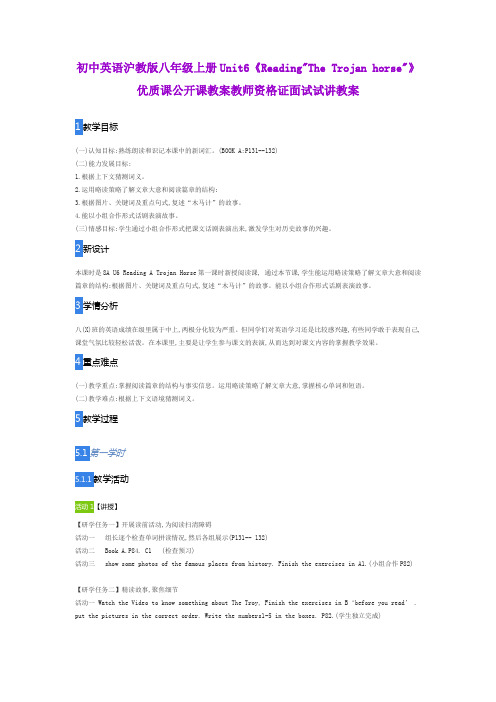
初中英语沪教版八年级上册Unit6《Reading"The Trojan horse"》优质课公开课教案教师资格证面试试讲教案1教学目标(一)认知目标:熟练朗读和识记本课中的新词汇。
(BOOK A:P131--132)(二)能力发展目标:1.根据上下文猜测词义。
2.运用略读策略了解文章大意和阅读篇章的结构;3.根据图片、关键词及重点句式,复述“木马计”的故事。
4.能以小组合作形式话剧表演故事。
(三)情感目标:学生通过小组合作形式把课文话剧表演出来,激发学生对历史故事的兴趣。
2新设计本课时是8A U6 Reading A Trojan Horse第一课时新授阅读课, 通过本节课,学生能运用略读策略了解文章大意和阅读篇章的结构;根据图片、关键词及重点句式,复述“木马计”的故事。
能以小组合作形式话剧表演故事。
3学情分析八(X)班的英语成绩在级里属于中上,两极分化较为严重。
但同学们对英语学习还是比较感兴趣,有些同学敢于表现自己,课堂气氛比较轻松活泼。
在本课里,主要是让学生参与课文的表演,从而达到对课文内容的掌握教学效果。
4重点难点(一)教学重点:掌握阅读篇章的结构与事实信息。
运用略读策略了解文章大意,掌握核心单词和短语。
(二)教学难点:根据上下文语境猜测词义。
5教学过程5.1第一学时教学活动1【讲授】【研学任务一】开展读前活动,为阅读扫清障碍活动一组长逐个检查单词拼读情况,然后各组展示(P131-- 132)活动二 Book A.P84. C1 (检查预习)活动三 show some photos of the famous places from history. Finish the exercises in A1.(小组合作P82)【研学任务二】精读故事,聚焦细节活动一 Watch the Video to know something about The Troy, Finish the exercises in B‘before you read’ . put the pictures in the correct order. Write the numbers1-5 in the boxes. P82.(学生独立完成)。
人教版八年级英语下册Unit6优秀教学案例
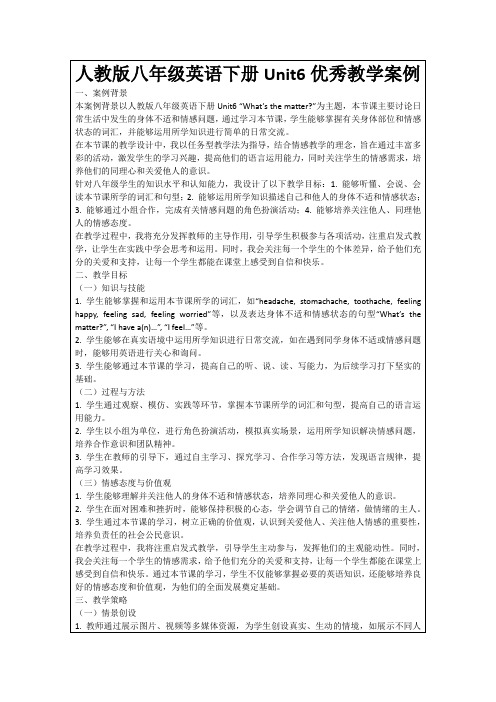
在教学过程中,我将充分发挥教师的主导作用,引导学生积极参与各项活动,注重启发式教学,让学生在实践中学会思考和运用。同时,我会关注每一个学生的个体差异,给予他们充分的关爱和支持,让每一个学生都能在课堂上感受到自信和快乐。
1.教师将学生分成小组,鼓励他们合作完成各项任务,如共同设计一个关于情感问题的对话剧本,并进行表演。
2.教师为每个小组提供必要的支持和指导,帮助他们克服困难,完成任务。
3.教师组织小组间的交流和分享,让学生相互学习,共同进步。
(四)反思与评价
1.教师引导学生对自己的学习过程进行反思,如思考自己在课堂活动中的表现、学习方法的适用性等。
2.教师邀请学生分享他们自己或身边人的身体不适和情感状态的经历,让学生初步感知本节课的主题。
3.教师简要介绍本节课的学习目标和学习内容,为学生明确学习方向。
(二)讲授新知
1.教师通过展示PPT,引导学生学习本节课所学的词汇和句型,如“headache, stomachache, toothache, feeling happy, feeling sad, feeling worried”等。
2.学生能够在真实语境中运用所学知识进行日常交流,如在遇到同学身体不适或情感问题时,能够用英语进行关心和询问。
3.学生能够通过本节课的学习,提高自己的听、说、读、写能力,为后续学习打下坚实的基础。
(二)过程与方法
1.学生通过观察、模仿、实践等环节,掌握本节课所学的词汇和句型,提高自己的语言运用能力。
人教版英语八年级上册Unit6课时教学设计
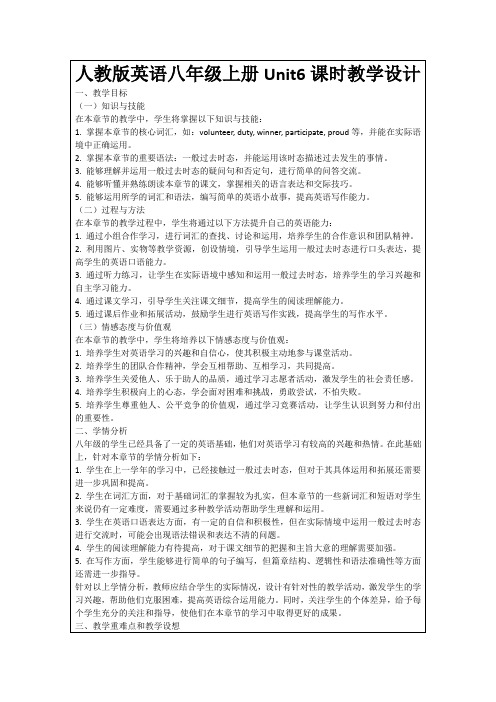
3.学生在英语口语表达方面,有一定的自信和积极性,但在实际情境中运用一般过去时态进行交流时,可能会出现语法错误和表达不清的问题。
4.学生的阅读理解能力有待提高,对于课文细节的把握和主旨大意的理解需要加强。
3.教师应关注学生的作业完成情况,及时给予反馈和指导,帮助学生发现并改正错误。
4.针对பைடு நூலகம்同层次的学生,可适当调整作业难度和要求,使每个学生都能在作业中找到适合自己的学习内容。
5.鼓励学生互相讨论、交流,分享学习心得,形成良好的学习氛围。
2.教师邀请学生分享他们对志愿者的认识和了解,激发学生的学习兴趣,为新课的学习做好铺垫。
3.教师通过提问方式,引导学生回顾一般过去时态的用法,为新课中一般过去时态的学习打下基础。
(二)讲授新知
1.教学内容:本节课主要学习一般过去时态的用法,以及与志愿者活动相关的词汇和短语。
2.教学方法:采用讲解、示范、练习相结合的方式进行教学。
五、作业布置
为了巩固本章节所学知识,提高学生的英语综合运用能力,特布置以下作业:
1.写作练习:请学生结合本章节的主题,编写一个小故事,描述一次志愿者活动经历。要求运用一般过去时态,不少于80词。
2.词汇练习:完成课后词汇练习题,巩固新学的词汇和短语,加强对单词拼写和用法的掌握。
3.阅读理解:阅读一篇关于志愿者活动的英文文章,并完成相应的阅读理解题目,提高阅读能力。
三、教学重难点和教学设想
(一)教学重难点
1.重点:本章节的重点在于掌握一般过去时态的用法,以及相关词汇和短语的运用。
难点:如何让学生在实际语境中灵活运用一般过去时态,避免语法错误和表达不清。
最新人教版新课标英语八年级上册Unit 6 公开课教学设计

最新人教版新课标英语八年级上册Unit6 公开课教学设计In this unit。
students will learn to talk about their ______ future plans using “what。
where。
when。
how” ns。
Some of the ns and fields of study they will explore include cooking。
medicine。
engineering。
music。
and science。
Key words and phrases they will encounter include “send。
team。
foreign。
n。
meaning。
discuss。
promise。
beginning。
improve。
physical。
hobby。
weekly。
schoolwork。
agree。
own。
personal。
nship。
grow up。
be sure about。
make sure。
write down。
have to do with。
take up。
agree with。
try one's best。
have in common。
make promise。
and for this reason.”One ___ students will have is about their ___。
For example。
when asked what they want to be when they grow up。
they might respond with “I want to be a basketball player”。
When asked how they plan to achieve this goal。
they might say “I'm going to ___ ns。
students will learn to use the structure “be going to” to express their ___.By the end of the unit。
新人教版英语初中八年级下册Unit 6 Section A公开课优质课教学设计
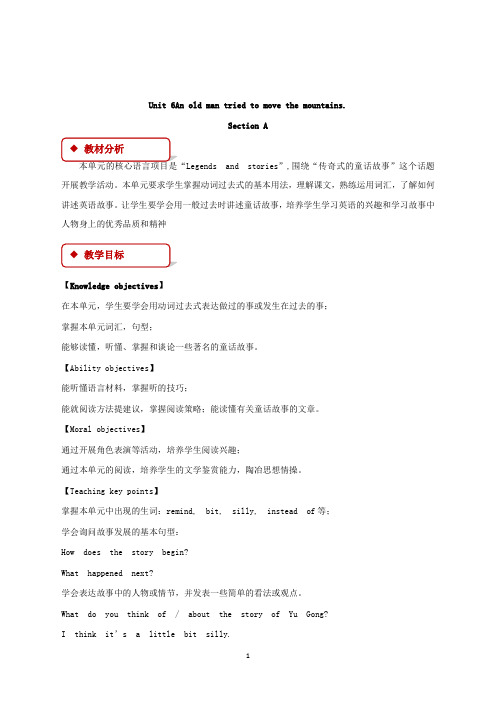
Unit 6An old man tried to move the mountains.Section Aand stories”,围绕“传奇式的童话故事”这个话题开展教学活动。
本单元要求学生掌握动词过去式的基本用法,理解课文,熟练运用词汇,了解如何讲述英语故事。
让学生要学会用一般过去时讲述童话故事,培养学生学习英语的兴趣和学习故事中人物身上的优秀品质和精神【Knowledge objectives】在本单元,学生要学会用动词过去式表达做过的事或发生在过去的事;掌握本单元词汇,句型;能够读懂,听懂、掌握和谈论一些著名的童话故事。
【Ability objectives】能听懂语言材料,掌握听的技巧;能就阅读方法提建议,掌握阅读策略;能读懂有关童话故事的文章。
【Moral objectives】通过开展角色表演等活动,培养学生阅读兴趣;通过本单元的阅读,培养学生的文学鉴赏能力,陶冶思想情操。
【Teaching key points】掌握本单元中出现的生词:remind, bit, silly, instead of等;学会询问故事发展的基本句型:How does the story begin?What happened next?学会表达故事中的人物或情节,并发表一些简单的看法或观点。
What do you think of / about the story of Yu Gong?I think it’s a little bit silly.I still don’t agree with you.【Teaching difficulties】学会表达故事中的人物或情节,并发表一些简单的看法或观点。
学习动词的过去式的用法。
Blackboard、Computer for multimedia use.Ⅶ、Teaching procedures:Free talk.Give Ss some pictures about stories to talk about:Which story do you like best?Step1 Warming upShow more stories to talk.Step2 PracticeShow Ss a video about Yu Gong Moves a Mountain.Activity 1a.Match the story with the pictures [a-d].Activity 1b.Listen and check (√) the facts you hear. Which story are Anna and Wang Ming talking about? Tell the story Yu Gong Moves a Mountain to your partner..Activity 1cDiscuss the questions with your partner..Activity 2aListen and number the pictures [1-4] in order to tell the story.Activity 2bListen again and circle the words you hear.Activity 2cLook at the pictures in 2a and tell the story in your own words. Step 3 Free talkWhat can you learn from the story?Step 4 Practicerole-play the conversation.Language points: explain the key words and phrases in section A-1. More exercises about the language points.Ask Ss to talk about Monkey KingStep 5 WatchingShow Ss a video about Monkey KingStep 6 PracticeActivity 3aRead the passage and answer the questions.Read again and summarize the main idea in each paragraph.Activity 3bRead the passage again and plete the chart about the Monkey King. Read again and do true or false.Activity 3cComplete the sentences below with phrases from the passage.Step 7 Free talkDo you like watching Journey to the West?Who do you like best? Why?What do you think about The Monkey King?Step 8 Learn some new words.Language points: explain the key words and phrases in section A-2. More exercises about the language points.Complete the sentences with these conjunctions.Uses of “unless”.Step9 Exercise.Uses of “as soon as” and “so ... that”.Do basic exercise.Step 10 PracticeActivity 4aFill in the blanks with unless, as soon as or so… that.Activity 4bFill in the blanks with the correct forms of the verbs in brackets. Activity 4cTell your partner about your favourite story.More exercises about the grammar.略。
初二英语上册unit6说课稿

初二英语上册unit6说课稿Unit 6 说课稿尊敬的各位老师,大家好。
今天,我将就初二英语上册的第六单元进行说课。
本单元的主题是“购物”,旨在通过与购物相关的语言点和活动,提高学生的英语交际能力。
一、教学目标1. 知识目标:学生能够掌握购物相关的词汇,如“size”, “color”, “price”, “discount”等,并能够使用这些词汇进行基本的购物对话。
2. 能力目标:通过模拟购物场景,学生能够运用所学词汇和句型进行实际的购物交流。
3. 情感目标:培养学生的购物礼仪和消费观念,理解并实践公平交易和诚信购物。
二、教学重点1. 购物相关的词汇和表达方式。
2. 如何询问物品的价格、颜色、尺寸等信息。
3. 表达购买意愿和拒绝购买的礼貌用语。
三、教学难点1. 学生能够灵活运用购物相关的句型进行交流。
2. 理解并运用购物时的礼貌用语和交际技巧。
四、教学方法1. 情景教学法:通过模拟购物场景,让学生在实际情境中学习和使用语言。
2. 合作学习法:鼓励学生分组合作,通过角色扮演等形式,共同完成购物任务。
3. 任务型教学法:设置具体的购物任务,让学生在完成任务的过程中学习和运用语言。
五、教学过程1. 导入(Lead-in):- 通过展示一些购物图片或视频,激发学生对购物话题的兴趣。
- 简单讨论学生平时的购物经历,引导学生思考购物时可能用到的英语表达。
2. 呈现(Presentation):- 教授购物相关的词汇和句型,如“Can I help you?”, “What size/color do you want?”, “How much is it?”等。
- 通过图片或实物,帮助学生直观理解词汇。
3. 练习(Practice):- 学生两人一组,进行角色扮演练习,模拟购物对话。
- 教师提供一些购物场景,让学生用所学句型进行对话。
4. 应用(Application):- 组织一个模拟购物活动,学生需要使用英语完成购物任务。
八年级英语Unit6课程教案
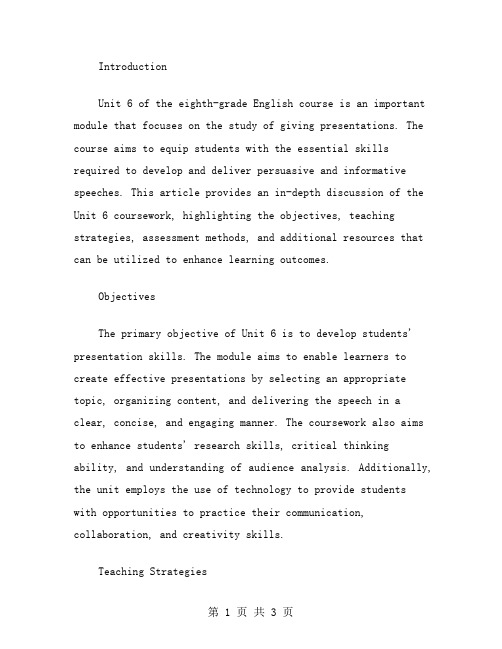
IntroductionUnit 6 of the eighth-grade English course is an important module that focuses on the study of giving presentations. The course aims to equip students with the essential skills required to develop and deliver persuasive and informative speeches. This article provides an in-depth discussion of the Unit 6 coursework, highlighting the objectives, teaching strategies, assessment methods, and additional resources that can be utilized to enhance learning outcomes.ObjectivesThe primary objective of Unit 6 is to develop students' presentation skills. The module aims to enable learners to create effective presentations by selecting an appropriate topic, organizing content, and delivering the speech in a clear, concise, and engaging manner. The coursework also aims to enhance students' research skills, critical thinking ability, and understanding of audience analysis. Additionally, the unit employs the use of technology to provide studentswith opportunities to practice their communication, collaboration, and creativity skills.Teaching StrategiesTo achieve the set learning objectives, the Unit 6 coursework uses a variety of teaching strategies. One of the primary teaching methods entails modeling, where teachers demonstrate effective oral presentation techniques to learners. Another teaching strategy is direct instruction, where teachers guide learners through the process of creating and delivering effective presentations. Also, cooperative learning is utilized in the course to encourage students to work together in groups to develop and review each other's presentations.Assessment MethodsEffective assessment methods are critical in determining students' progress and understanding. Unit 6 employs avariety of assessment strategies, including formative and summative assessments. Formative assessments are used to provide feedback to students on their progress towards attaining the set objectives. The summative assessment, on the other hand, is used to evaluate students' overall understanding of the course content. Assessment methods employed in the course include oral presentations, written assignments, group projects, and peer assessments.Additional ResourcesUnit 6 coursework leverages additional resources to promote effective learning outcomes. ESL libraries, online video tutorials, and online podcasts are among the resources utilized to provide students with access to a wider range of information. Additionally, inline quiz tools, presentation software, and online discussion boards enable students to practice their presentation and critical thinking skills.ConclusionIn summary, Unit 6 of the eighth-grade English course provides learners with the fundamental skills required to create and deliver effective presentations. The unit employs a variety of teaching strategies, assessment methods, and additional resources to ensure that students acquire the necessary knowledge and skills required to excel in oral presentations. Through the successful completion of this course, learners acquire the skills necessary to become successful presenters, and communicators.。
人教版八年级下册英语Unit 6集体备课教案
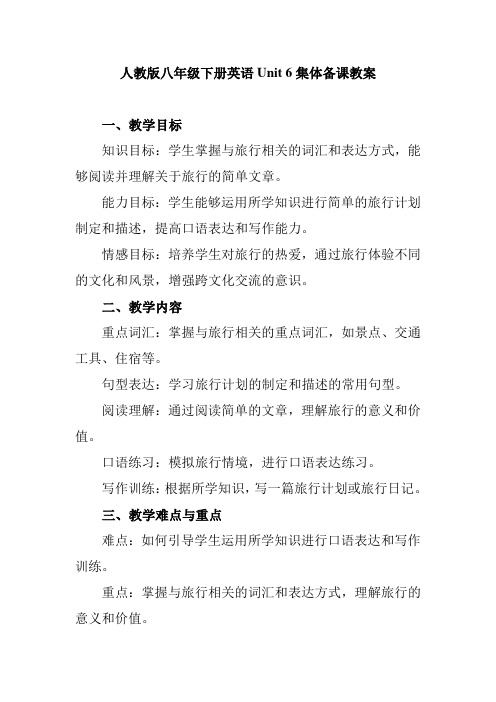
人教版八年级下册英语Unit 6集体备课教案一、教学目标知识目标:学生掌握与旅行相关的词汇和表达方式,能够阅读并理解关于旅行的简单文章。
能力目标:学生能够运用所学知识进行简单的旅行计划制定和描述,提高口语表达和写作能力。
情感目标:培养学生对旅行的热爱,通过旅行体验不同的文化和风景,增强跨文化交流的意识。
二、教学内容重点词汇:掌握与旅行相关的重点词汇,如景点、交通工具、住宿等。
句型表达:学习旅行计划的制定和描述的常用句型。
阅读理解:通过阅读简单的文章,理解旅行的意义和价值。
口语练习:模拟旅行情境,进行口语表达练习。
写作训练:根据所学知识,写一篇旅行计划或旅行日记。
三、教学难点与重点难点:如何引导学生运用所学知识进行口语表达和写作训练。
重点:掌握与旅行相关的词汇和表达方式,理解旅行的意义和价值。
四、教具和多媒体资源黑板:用于书写重点词汇和句型。
投影仪:播放与旅行相关的图片和视频,增强学生对旅行的感性认识。
教学软件:用于进行互动练习和测试。
五、教学方法激活学生的前知:通过提问学生过去的旅行经历和感受,激活学生的相关背景知识。
教学策略:采用讲解、示范、小组讨论、角色扮演等多种教学方法,引导学生积极参与课堂活动。
学生活动:组织学生进行旅行计划制定、口语表达和写作训练等活动,提高学生的实践能力和合作意识。
六、教学过程导入(5分钟)通过投影仪展示一些美丽的旅行景点图片,吸引学生的注意力。
随后提问学生关于旅行的感受和经历,引导学生进入本单元的主题。
讲授新课(30分钟)(1)介绍本单元的重点词汇和句型,通过例句和情境模拟帮助学生理解并运用。
(2)阅读理解:让学生阅读一篇关于旅行的文章,并提出问题让学生回答,检验学生的理解程度。
(3)口语练习:组织学生进行小组讨论,制定一个简单的旅行计划,并进行口头表达。
教师给予指导和反馈。
(4)写作训练:让学生写一篇旅行计划或旅行日记,要求运用所学知识,注意语法和拼写错误。
教师给予指导和评价。
八年级英语Unit6公开课教案.doc
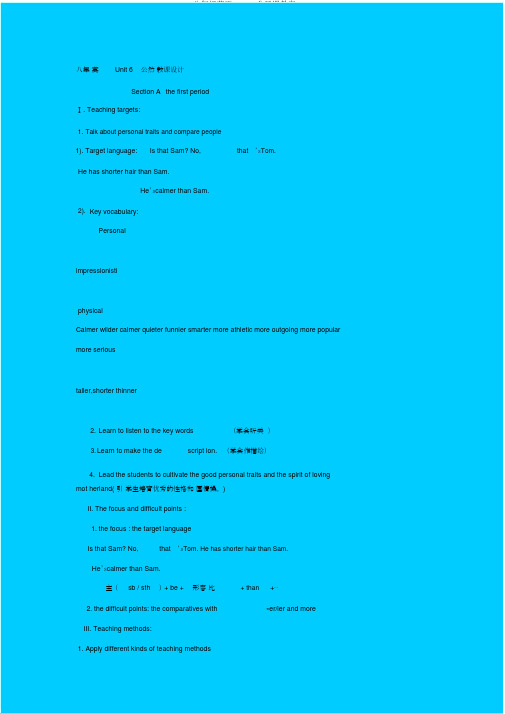
八年英Unit 6公然教课设计Section A the first periodⅠ. Teaching targets:1.Talk about personal traits and compare people1). Target language: Is that Sam? No,that’s Tom.He has shorter hair than Sam.He’s calmer than Sam.2).Key vocabulary:PersonalimpressionistiphysicalCalmer wilder calmer quieter funnier smarter more athletic more outgoing more popular more serioustaller,shorter thinner2.Learn to listen to the key words(学会听关)3.Learn to make the de script ion.(学会作描绘)4.Lead the students to cultivate the good personal traits and the spirit of loving mot herland( 引学生培育优秀的性格和国情操。
)II. The focus and difficult points :1.the focus : the target languageIs that Sam? No,that’s Tom. He has shorter hair than Sam.He’s calmer than Sam.主(sb / sth) + be +形容比+ than+⋯2. the difficult points: the comparatives with–er/ier and moreIII.Teaching methods:1.Apply different kinds of teaching methods1.) task-based teaching approach2.) The cognitive approach3.) The oral approach4.) The natural approach2. Learning method guidance(学法指导)1.) Autonomous learning and cooperative investigation自主学习,合作探究2.) Let the students work in pairs to learn the cooperative learning3.) Students learn to describe each other and respect others4.) Ask students to learn by doing.3.The teaching means (教课手段)Multi-media, computer, projector, courseware , Flash pictures, body language, listening, practice, chart, photos, record,pattern-drills, question-answer drills.Ⅳ . Teaching steps:Step 1. Revision1. Greetings.2. Review the de script ion words of personalities and appearance.( cultivate the students’multiple intelligences培育学生的多元智能。
英语人教版八年级上册Unit6公开课教案
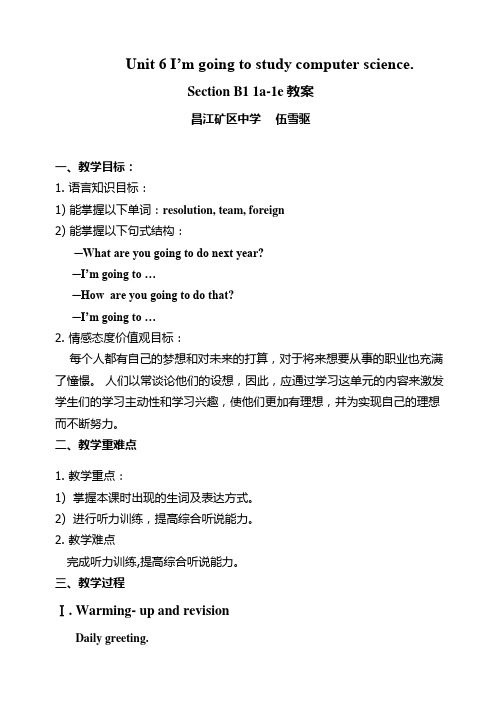
Unit 6 I’m going to study computer science.Section B1 1a-1e教案昌江矿区中学伍雪驱一、教学目标:1. 语言知识目标:1) 能掌握以下单词:resolution, team, foreign2) 能掌握以下句式结构:─What are you going to do next year?─I’m going to …─How are you going to do tha t?─I’m going to …2. 情感态度价值观目标:每个人都有自己的梦想和对未来的打算,对于将来想要从事的职业也充满了憧憬。
人们以常谈论他们的设想,因此,应通过学习这单元的内容来激发学生们的学习主动性和学习兴趣,使他们更加有理想,并为实现自己的理想而不断努力。
二、教学重难点1. 教学重点:1) 掌握本课时出现的生词及表达方式。
2) 进行听力训练,提高综合听说能力。
2. 教学难点完成听力训练,提高综合听说能力。
三、教学过程Ⅰ. Warming- up and revisionDaily greeting.2. 头脑风暴:说出表示的职业名词teacher, nurse, doctor, nurse, actor, actress, soccer player, pilot, computer programmer, pianist, scientist, violinist…3. 说理想,谈打算。
I want to be … I’m going to …让学生们依次说出他们的理想及打算如何去做。
(可以用大屏幕提示职业或用学生们自己刚才写的职业)Ⅱ. Presentation1. T: Do you have any New Year’s Resolutions?Let some Ss answer your questions.2. Present some other New Year’s Resolutions on the big screen.e.g. learn to play the piano; make the soccer team; get good grades;eat healthier food; get lots of exercise3. Let Ss try remember these resolutions and think of other resolutions.Ⅲ. Talking1. Tell your partners your New Year’s Resolutions.2. S1: I’m going to get lots of exercise. I’m going to make a bask etball team. S2: I’m going to learn another foreign language. I’m going to learn French. S3: …3. Let Ss say as many resolutions as they can.Ⅳ. ListeningWork on 1c:1. Tell Ss to read the resolutions in 1a. Tell Ss to listen and circle the resolutions they hear.2. Play the recording for the Ss to listen and circle.3. Check the answers.Work on 1d:1.Listen again. Write how the people are going to make their resolutions work. Look at the three conversations in 1d. How are they going to do it? Listen and try to fill in the blanks.2. Ss listen to the recording carefully and try to fill in the blanks.3. Play the recording again and check the answers with the class.Ⅴ. Sharing TimeSome pairs share their conversations with their classmates.Ⅵ. GroupworkWork on 1e.1. Make a list of other resolutions and how you are going to make them work . Discuss them with your group and fill in the chart.Then share the report from the reporter.2. Some reporters share their reports to the class.You can do it like this —Hello, everyone! In my group, XXX is going to …H e’s/S he’s going to …We’re going to study harder to make them come true.That’s all. Thanks a lot.Ⅶ.Sharing TimeShare the report from the reporter.Ⅷ. ExercisesFinish the exercises and check the answers.Ⅸ.SummarySummarize the key phrases and the key sentences that they have learned this class.Ⅹ. Homework1. Remember the key phrases by reading.2. Read the conversations after class.。
- 1、下载文档前请自行甄别文档内容的完整性,平台不提供额外的编辑、内容补充、找答案等附加服务。
- 2、"仅部分预览"的文档,不可在线预览部分如存在完整性等问题,可反馈申请退款(可完整预览的文档不适用该条件!)。
- 3、如文档侵犯您的权益,请联系客服反馈,我们会尽快为您处理(人工客服工作时间:9:00-18:30)。
八年级英语Unit 6公开课教案Section A the first periodⅠ. Teaching targets:1. Talk about personal traits and compare people1). Target language: Is that Sam? No, that’s Tom.He has shorter hair than Sam.He’s calmer than Sam.2). Key vocabulary:2.Learn to listen to the key words (学会听关键词)3. Learn to make the description. (学会作描述)4. Lead the students to cultivate the good personal traits and the spirit of loving motherland(引导学生培养良好的性格和爱国情操。
)II. The focus and difficult points :1. the focus : the target languageIs that Sam? No, that’s Tom. He has shorter hair than Sam.He’s calmer than Sam.主语(sb / sth)+ be +形容词比较级+ than +…2. the difficult points: the comparatives with –er/ier and moreIII. Teaching methods:1. Apply different kinds of teaching methods1.) task-based teaching approach2.) The cognitive approach3.) The oral approach4.) The natural approach2. Learning method guidance (学法指导)1.) Autonomous learning and cooperative investigation自主学习,合作探索2.) Let the students work in pairs to learn the cooperative learning3.) Students learn to describe each other and respect others4.) Ask students to learn by doing.3.The teaching means (教学手段)Multi-media, computer, projector, courseware , Flash pictures, body language, listening, practice, chart, photos, record,pattern-drills, question-answer drills.Ⅳ. Teaching steps:Step 1. Revision1. Greetings.2. Review the description words of personalities and appearance.(cultivate the students’ multiple intelligences培养学生的多元智能。
)(让学生展示自己小时候与现在的照片,用所学过的形容词分别形容每张照片,然后进行比较,引出本节课所要学的内容—形容词的比较级)Step 2.Presentation:Say , Today we’re going to learn a new unit . In this unit we will learn to talk about personal traits and compare people. Now I’ll ask two students to come to the front.1. Ask two students to stand in the front of classroom the other students tell the differences betweenthem.(培养学生的直观思维。
)2. Using the flash pictures to share the comparatives and help students cultivate the spirit ofloving motherland.(情感教学)3. Show the pictures of 1a ask students to tell what they see.(Intuitive Teaching --直观教学)T: What can you see in the picture?S: Two boys.T: That’s right . This is Pedro and this is Paul. They’re brothers.Who is taller, Pedro or Paul ?S: Pedro.T: That’s right. Pedro is taller. (show the sentence and class repeat)S: Pedro is taller.T: Pedro is heavier than Paul . Paul is thinner than Pedro.(show the sentences and class repeat)S:Pedro is heavier than Paul . Paul is thinner than Pedro.In the same way , teach the sentences of the other two pictures.Tina is wilder than Tara.Tara is calmer than Tina.Sam is wilder than Tom.Sam has longer hair than Tom.Tom is calmer than Sam . Tom has short hair than Sam.Step3. Practice1. Ask students to read these sentences again.Pedro is taller. Pedro is heavier than Paul .Paul is thinner than Pedro.Tina is wilder than Tara.Tara is calmer than Tina.Sam is wilder than Tom.Sam has longer hair than Tom.Tom is calmer than Sam . Tom has short hair than Sam.2. Ask students to match each word with the opposite in activity 1a.3.Ask students to describe each picture in activity 1a.(Appliance Teaching--应用教学)4. Task 1. What’s change in your life? (use the photos )Step4.Practice1. Ask students to listen to the conversations and number the twins.2. Play the tape.3.Check the answers.Step5. Pair work (cultivate the cooperative learning)1. Point out the sample conversation in activity 1c.2. Say the sample conversation again with a student.3.Ask students to work in pairs like this and make their own conversations about the people inthe picture .4.Ask several pairs to say one or more of their conversations to the class.Step6. Listen and write(cultivate the autonomous learning)1. Point out the two columns and read the headings: -er, -ier and more2. Tell the students what to do in this activity. Play the recording the first time. Students onlylisten.3. Ask them to listen carefully and write the –er and –ier words from the box on the left in thefirst column and the words that use more in the second column.4. Play the recording the second time .5. Check the answers.Step7. Grammar Focus:1. 形容词比较级的用法。
规则变化2. 形容词比较级的构成。
(出示幻灯片)不规则变化3. 句型:主语+动词+比较级+tha n…Step8. Summary and taskTask 2. What are the differences between you and your sister or brother?Step9. HomeworkWrite out the comparative degrees of the following words.short shy serious thintall funny outgoinglong moody generousstraight heavy easygoingsmart curly unfriendly/ friendlyquiet interesting板书:1. wild calm athletic2. Is that Sam? No, that’s Tom. He has shorter hair than Sam.He’s calmer than Sam.。
